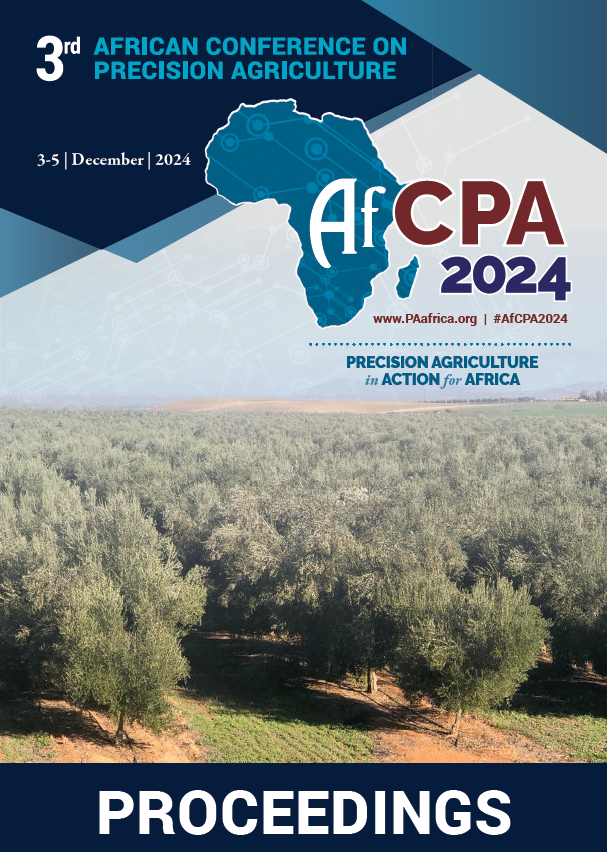Download the Conference Proceedings
Proceedings
Topics
| Filter results9 paper(s) found. |
|---|
1. Spatial Interpolation for Mapping Hydraulic Soil Properties in GIS EnvironmentSoil water information is an essential input for environmental, hydrological or land surface models. There is a need for reliable soil water information with current coverage in the area. A number of 60 soil profiles data were evaluated for the performance of estimates inverse distance weighting to map some of the soil quality properties. soil profiles were used for the application of geostatistics. Maps with the investigated coverage were produced with the soil information available about so... M.A. Abdelrahman, A.M. Saleh, M.M. El sharkawy, E. Farg, S.M. Arafat |
2. Preparation of a precision ripping plan using manual vertical penetrometer measurementsLarge weight power engines and tools used in agriculture significantly contribute to the formation of compacted and thickening layers starting from the soil surface. There are suitable deep ripping technologies to eliminate harmful soil compaction, which are extremely energy and cost demanding. In precision agriculture, it is possible to treat spatially delimited unfavourable soil patches. The bulk density (g/cm3) of the soil was calculated from the soil resistance and moisture con... T. Rátonyi, P. Ragán, A. Széles, P. Fejér, E. Harsányi, I. Bácskai |
3. A cheap alternative to data management and creating of yield maps of small-plot field experimentsLong-term field trials provide an opportunity to examine the long-term effects of crop production factors and the effect of different crop years can also be analysed. In the long-term field trial, spatial representation of the data belonging to each plot might be necessary for the purpose of soil heterogeneity analysis, working hypothesis, or even presentation. Researchers dealing with long-term field trials usually store the measurement data for a given experiment in Excel or in a database o... P. Ragán, T. Rátonyi, A. Széles, P. Fejér, I. Bácskai, E. Harsányi |
4. LAND DEGRADATON RISK ASSESSMENT AT A SITE IN AFIJIO LOCAL GOVERNMENT AREA OF OYO STATE, NIGERIASoils are considered non –renewable and it is a limited resource therefore the continuous use of land without appropriate management practices leads to land degradation in the long run. Land degradation is the decline in soil quality caused by natural factors or, more often, by improper use/management usually for agricultural, pastoral or urban purposes. This study aims to map the soils while also assessing the state of land degradation in Afijio Local government area of Oyo state. The ... |
5. Some essential nutrients, active limestone and pH status of north and center Tunisian soils.Tunisia is a North African country characterized by a Mediterranean climate in the north and Saharan climate in the south part of the country, which resulted in a high geo-morphological diversity of its soils. The last are known by their various fertility status that is affected by abiotic constrains such as salinity, drought, erosion and low organic matter concentration. Thereby, soil fertility is largely linked to geographical position, making fertilization recommendatio... A. Hachana, I. Hemissi, I. Achour, A. Souissi, B. Sifi |
6. DIGITAL MAPPING OF EXCHANGEABLE CATIONS IN SOILS OF SOUTHWESTERN NIGERIASoil acidity and low exchangeable cation are the major soil fertility challenges resulting in low crop productivity in Southwest Nigeria. Digital soil mapping is an effective way to achieve precision agriculture. However, most of the research work on soil exchangeable cations as soil information was not geo-referenced, The study created geo-database and developed a digitized map of soil exchangeable cations Indicating the spatial distribution in soils of southwestern Nigeria. Secondary d... O.E. Awosiyan, I.K. Mary, F.A. Adesina |
7. Soil organic carbon mapping in Tunisia: comparison of different interpolation methodsSoil organic carbon (SOC) stock is an important carbon pool in terrestrial ecosystems. It plays an important role in agricultural productivity and is often used as a key indicator of soil quality whether for soil fertility or climate regulation. SOC stocks are difficult to estimate due to the large spatial variability. In this way, many different techniques have been conducted for predicting and mapping SOC content. However, although numerous techniques are in use, there is still debate on wh... M. Barbouchi, H. Bahri, A. Souissi, H. Cheikh m'hamed, M. Annabi |
8. Comparison of soil testing and scanning methods for spatial variability assessment of soil fertility: implications for precision agricultureUnderstanding spatial variability of soil fertility is a key to variable rate nutrient applications for precision fertilization. The objective of this study was to assess field spatial variability of soil fertility using two approaches, a gridded soil testing and a scanner-based technique. Measurements were performed on a quarter pivot silage corn field of 13 ha. For the first approach, soil samples were taken on a geopositioned grid and were analyzed for the main physicochemical and nutrient... R. Bouabid |
9. Cartographie interactive des exploitations de noix de cajou des producteurs de la coopérative COPRODIGO de GohitaflaL’agriculture a connu de profondes mutations : la spécialisation, la réduction de la main d’œuvre agricole, la mécanisation croissante. Ces dernière années, l'intégration des technologies de l'information et de la communication dans la gestion des exploitations agricoles a donné naissance à l'agriculture de précision. Ces innovations technologiques permettent de piloter et d’optimiser les p... S. Koné |
